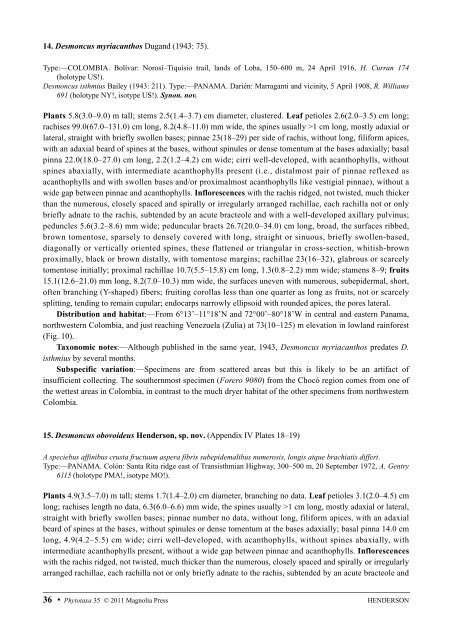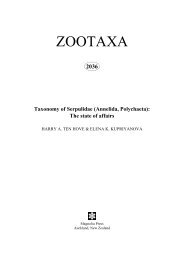Create successful ePaper yourself
Turn your PDF publications into a flip-book with our unique Google optimized e-Paper software.
14. Desmoncus myriacanthos Dugand (1943: 75).<br />
Type:—COLOMBIA. Bolívar: Norosí–Tiquísio trail, lands of Loba, 150–600 m, 24 April 1916, H. Curran 174<br />
(holotype US!).<br />
Desmoncus isthmius Bailey (1943: 211). Type:—PANAMA. Darién: Marraganti and vicinity, 5 April 1908, R. Williams<br />
691 (holotype NY!, isotype US!). Synon. nov.<br />
Plants 5.8(3.0–9.0) m tall; stems 2.5(1.4–3.7) cm diameter, clustered. Leaf petioles 2.6(2.0–3.5) cm long;<br />
rachises 99.0(67.0–131.0) cm long, 8.2(4.8–11.0) mm wide, the spines usually >1 cm long, mostly adaxial or<br />
lateral, straight with briefly swollen bases; pinnae 23(18–29) per side of rachis, without long, filiform apices,<br />
with an adaxial beard of spines at the bases, without spinules or dense tomentum at the bases adaxially; basal<br />
pinna 22.0(18.0–27.0) cm long, 2.2(1.2–4.2) cm wide; cirri well-developed, with acanthophylls, without<br />
spines abaxially, with intermediate acanthophylls present (i.e., distalmost pair of pinnae reflexed as<br />
acanthophylls and with swollen bases and/or proximalmost acanthophylls like vestigial pinnae), without a<br />
wide gap between pinnae and acanthophylls. Inflorescences with the rachis ridged, not twisted, much thicker<br />
than the numerous, closely spaced and spirally or irregularly arranged rachillae, each rachilla not or only<br />
briefly adnate to the rachis, subtended by an acute bracteole and with a well-developed axillary pulvinus;<br />
peduncles 5.6(3.2–8.6) mm wide; peduncular bracts 26.7(20.0–34.0) cm long, broad, the surfaces ribbed,<br />
brown tomentose, sparsely to densely covered with long, straight or sinuous, briefly swollen-based,<br />
diagonally or vertically oriented spines, these flattened or triangular in cross-section, whitish-brown<br />
proximally, black or brown distally, with tomentose margins; rachillae 23(16–32), glabrous or scarcely<br />
tomentose initially; proximal rachillae 10.7(5.5–15.8) cm long, 1.3(0.8–2.2) mm wide; stamens 8–9; fruits<br />
15.1(12.6–21.0) mm long, 8.2(7.0–10.3) mm wide, the surfaces uneven with numerous, subepidermal, short,<br />
often branching (Y-shaped) fibers; fruiting corollas less than one quarter as long as fruits, not or scarcely<br />
splitting, tending to remain cupular; endocarps narrowly ellipsoid with rounded apices, the pores lateral.<br />
Distribution and habitat:—From 6°13’–11°18’N and 72°00’–80°18’W in central and eastern Panama,<br />
northwestern Colombia, and just reaching Venezuela (Zulia) at 73(10–125) m elevation in lowland rainforest<br />
(Fig. 10).<br />
Taxonomic notes:—Although published in the same year, 1943, Desmoncus myriacanthos predates D.<br />
isthmius by several months.<br />
Subspecific variation:—Specimens are from scattered areas but this is likely to be an artifact of<br />
insufficient collecting. The southernmost specimen (Forero 9080) from the Chocó region comes from one of<br />
the wettest areas in Colombia, in contrast to the much dryer habitat of the other specimens from northwestern<br />
Colombia.<br />
15. Desmoncus obovoideus Henderson, sp. nov. (Appendix IV Plates 18–19)<br />
A speciebus affinibus crusta fructuum aspera fibris subepidemalibus numerosis, longis atque brachiatis differt.<br />
Type:—PANAMA. Colón: Santa Rita ridge east of Transisthmian Highway, 300–500 m, 20 September 1972, A. Gentry<br />
6115 (holotype PMA!, isotype MO!).<br />
Plants 4.9(3.5–7.0) m tall; stems 1.7(1.4–2.0) cm diameter, branching no data. Leaf petioles 3.1(2.0–4.5) cm<br />
long; rachises length no data, 6.3(6.0–6.6) mm wide, the spines usually >1 cm long, mostly adaxial or lateral,<br />
straight with briefly swollen bases; pinnae number no data, without long, filiform apices, with an adaxial<br />
beard of spines at the bases, without spinules or dense tomentum at the bases adaxially; basal pinna 14.0 cm<br />
long, 4.9(4.2–5.5) cm wide; cirri well-developed, with acanthophylls, without spines abaxially, with<br />
intermediate acanthophylls present, without a wide gap between pinnae and acanthophylls. Inflorescences<br />
with the rachis ridged, not twisted, much thicker than the numerous, closely spaced and spirally or irregularly<br />
arranged rachillae, each rachilla not or only briefly adnate to the rachis, subtended by an acute bracteole and<br />
36 Phytotaxa 35 © 2011 <strong>Magnolia</strong> <strong>Press</strong><br />
HENDERSON
















